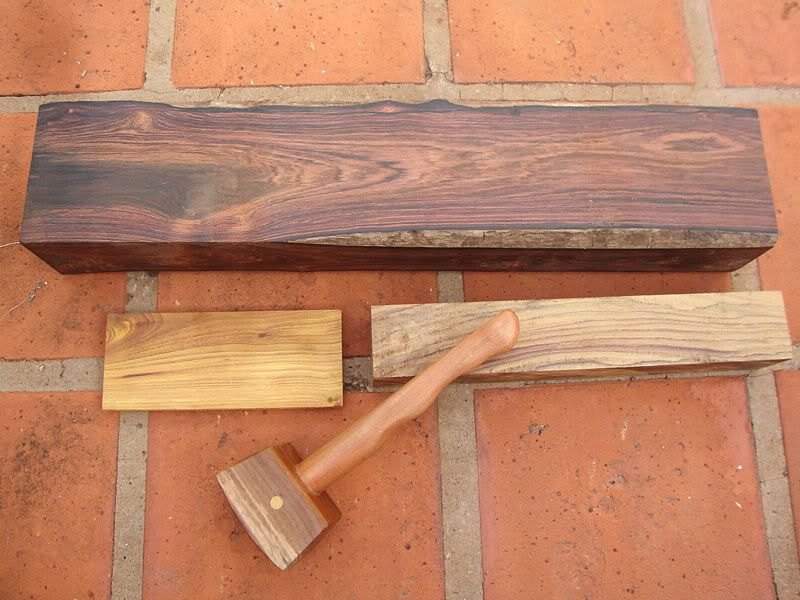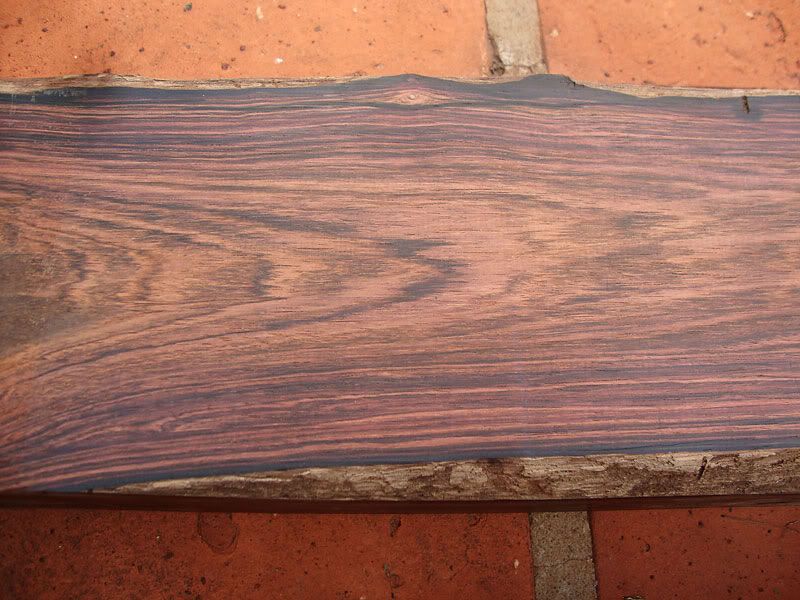 Thanks: 0
Thanks: 0
 Needs Pictures: 0
Needs Pictures: 0
 Picture(s) thanks: 0
Picture(s) thanks: 0
Results 1 to 9 of 9
-
24th June 2012, 11:14 AM #1
 Jacarandá-Cabiúna - Brazilian rosewood
Jacarandá-Cabiúna - Brazilian rosewood
A friend that lives near the Bahia state (Brazil) found a fallen tree of Jacarandá and sent me a piece. I am posting photos for you see the wood.
Although I am a biologist, I can not say the exactly scientific name of the tree, I think that is a Dalbergia nigra, but i am not sure. Here it is know as "Jacarandá Cabiúna", a variety or even another specie, I dont know, of brazilian rosewood. It is a little different from the classic Jacarandá.

The larger piece is Jacarandá Cabiúna, it has 70 x 15 x 10 cm. The smaller piece on the right is the classic Jacarandá. And the piece on the left is know here as Vinhático, a golden wood, its scientific name is Platymenia sp. from the Fabaceae family, possibly the Plathymenia foliolosa species. The mallet is made by the friend that sent the wood and its head is from Ipê, Tabebuia sp.

Here is a close from the wood. Is one of the more beautifull woods that I see in my hands. And the photo does not really show the beauty of the wood.
I do not even sawed a piece from this wood. I will need to very inspired to use this wood, to make something that does justice to its beauty, maybe a box, or a jewelry box... I also think to make a spokeshave with this wood, and send a piece to a friend, that makes beautifull marking gauges like this on my bench: http://i37.photobucket.com/albums/e9...M_Graminho.jpg
-
24th June 2012 11:14 AM # ADSGoogle Adsense Advertisement
- Join Date
- Always
- Location
- Advertising world
- Age
- 2010
- Posts
- Many
-
24th June 2012, 02:46 PM #2

Beautiful wood love them both the finished product excellent.
Our Aussie native Jacaranda is much whiter as seen in my rough turning.
Hey artme you might need to get to know this fellow he's a woodworker from Brazil.
-
25th June 2012, 07:07 AM #3
 Senior Member
Senior Member











- Join Date
- Oct 2009
- Location
- San Francisco, California, USA
- Posts
- 331

The Dalbergia species that grow in Bahia are:
<table border="0" cellpadding="0" cellspacing="0" width="100%"><tbody><tr class="lr" valign="top"><td>
</td><td>
</td><td id="lo">Dalbergia acuta Benth.</td><td id="lo">
</td> </tr> <tr class="lr" valign="top"><td>
</td><td>
</td><td id="lo">Dalbergia catingicola Harms</td><td id="lo">
</td> </tr> <tr class="lr" valign="top"><td>
</td><td>
</td><td id="lo">Dalbergia cearensis Ducke</td><td id="lo">
</td> </tr> <tr class="lr" valign="top"><td>
</td><td>
</td><td id="lo">Dalbergia decipularis Rizzini & A.Mattos</td><td id="lo">
</td> </tr> <tr class="lr" valign="top"><td>
</td><td>
</td><td id="lo">Dalbergia ecastaphyllum (L.) Taub.</td><td id="lo">
</td> </tr> <tr class="lr" valign="top"><td>
</td><td>
</td><td id="lo">Dalbergia elegans A.M.Carvalho</td><td id="lo">
</td> </tr> <tr class="lr" valign="top"><td>
</td><td>
</td><td id="lo">Dalbergia foliolosa Benth.</td><td id="lo">
</td> </tr> <tr class="lr" valign="top"><td>
</td><td>
</td><td id="lo">Dalbergia frutescens (Vell.) Britton</td><td id="lo">
</td> </tr> <tr class="lr" valign="top"><td>
</td><td>
</td><td id="lo">Dalbergia frutescens (Vell.) Britton var. frutescens</td><td id="lo">
</td> </tr> <tr class="lr" valign="top"><td>
</td><td>
</td><td id="lo">Dalbergia glaucescens (Mart. ex Benth.) Benth.</td><td id="lo">
</td> </tr> <tr class="lr" valign="top"><td>
</td><td>
</td><td id="lo">Dalbergia lateriflora Benth.</td><td id="lo">
</td> </tr> <tr class="lr" valign="top"><td>
</td><td>
</td><td id="lo">Dalbergia miscolobium Benth.</td><td id="lo">
</td> </tr> <tr class="lr" valign="top"><td>
</td><td>
</td><td id="lo">Dalbergia nigra (Vell.) Allemão ex Benth.</td></tr></tbody></table>
The genus Plathymenia has only one species, P. reticulata. Here are the states where it grows:
- Norte (Amapá, Pará, Amazonas),
- Nordeste (Maranhão, Piauí, Ceará, Bahia),
- Centro-Oeste (Mato Grosso, Goiás, Distrito Federal, Mato Grosso do Sul),
- Sudeste (Minas Gerais, Espírito Santo, São Paulo, Rio de Janeiro),
- Sul (Paraná)
-
25th October 2012, 01:45 PM #4
 New Member
New Member











- Join Date
- Oct 2012
- Location
- USA
- Posts
- 1
 Jacarandá-Cabiúna - Brazilian rosewood
Jacarandá-Cabiúna - Brazilian rosewood
I am also a biologist and I specialize in jacaranda. Most woodworkers say that the scent of Dalbergia nigra is so special that they can recognize it any time. Why do you think it is not Dalbergia nigra? It does no smell right for D. nigra?
D. nigra often has greenish colors in it. Do I see some green on the left end of the piece? The colors on my computer screen may be off.
Please save the scraps and the dust. Most colored woods can be matched with known samples from dust and especially scraps. Of the species of jacaranda of Bahia Dalbergia miscolobium is a definite possibility. I have a small piece that I use in the lab for standard. D. foliolosa is also a possibility. I do not know the wood of all trees on the Bahia list. D. ecastaphyllum is not growing that big and the wood is pink-red.
-
31st August 2013, 03:20 PM #5

Woodid
I saw your post only now. My doubt is because here has a wood that they know as "jacaranda da bahia", that I think is the classic rosewood; and a wood know as "jacaranda cabiuna" or "caviuna". The major doubt is because I never used rosewood before, only once and was the same wood from the smaller piece from the right. Brazil has so many species and woods and is so big that we have several popular names to designate the same wood, then is difficult to have entirely sure upon the wood if you do not worked many times with them.
The big piece is not greenish, the chance of greenish if it is mixed to black. But the smell is like... rose! I recently sawed a piece and definitely it smell like rose.
Thanks!
-
31st August 2013, 07:39 PM #6
 Senior Member
Senior Member











- Join Date
- May 2009
- Location
- Somerset, UK
- Posts
- 445

List of common names (including several 'Jacarandas') for Dalbergia nigra Allem. ex Benth. [Fabaceae] here.
<small>Wood Explorer
</small>What you say & what people hear are not always the same thing.
http://www.remark.me.uk/
-
1st September 2013, 10:50 PM #7
 Skwair2rownd
Skwair2rownd











- Join Date
- Nov 2007
- Location
- Dundowran Beach
- Age
- 76
- Posts
- 19,922

Oi Tomazlli, todu bem? Faz tempo que voce' nao' aparece!
Looks suspiciously like Jacaranda do Bahia to me. My wife has relatives in Campos who have a house
full of furniture made from this beautiful timber . Many of the pieces are well over 100 years old.
Some are supposed to be 200 years old.
I notice Runge is a prime suspect among the contributors here. I would have been vastly disappointed
had he not spoken!!
For mine, the fotos certainly scream dalbergia.
Love the Ipe mallet!!!


Ipe is a beautiful timber and one of the main arterial streets through Campos is lined with Ipe that were planted
under the direction of my wifé's grandfather when he was mayor of the city.
Those trees are Ipe Amarello and when in flower are just gorgeous.
Just for you Wheelin, we don't have a native Jacaranda. All those beautiful mauve flowering specimens we see,
and the white flowering type also, are of Brazillian origin.
When my inlaws - minha sogro minha sogra - were in Australia they commented on the wonderful specimens of
these trees that they saw. They regarded them as superior to anything in Brasil at that time.
Tshau Amigo!!
-
2nd September 2013, 08:34 AM #8

Old-Biker-UK
In the list has the "cabiuna" common name. I am thinking that is Dalbergia for sure.
Your location, Somerset, remembers me a couple of books that I read, from Bernard Cornwell, very good books!!!
Artme
What is the news from Australia? Brazil is a bit sick, the disease is called communism and corruption in politics, but beyond this everything is all right!
but beyond this everything is all right! 
I am convincing me more and more that the wood is Dalbergia. And, even if is not Dalbergia, the beautiful of the wood is so great that sure know the species not matter. I made a mallet with this wood, take a look: https://www.woodworkforums.com/f11/wo...charge-175754/ The finished wood is very similar to Dalbergia pictures on the net.
A single one Ipe when in flowers is beautiful, a street lined with Ipe is splendid! In Pantanal the yellow ipe is commonly know as "para tudo", translating it is "for everything", because its herbal medicine properties: the leaves is for something problem, the bark for something, thge sap for something, and so...
Australia looks me a good place to visit. Some university friends had training (internship?) in Australia. If I had continue my studies further more, maybe I have gone there to make a internship. I have a class colleague that lives therein Australia. Maybe I go some day to visit!
See you!
-
2nd September 2013, 06:13 PM #9
 Skwair2rownd
Skwair2rownd











- Join Date
- Nov 2007
- Location
- Dundowran Beach
- Age
- 76
- Posts
- 19,922

Oi amigo!!
Yes, all our friends and family in Brazil tell us of the problems.
I have followed the story of the port of Acu with some interest, but still cannot
see why Ike Batista stepped aside.
The main problem here is not corruption, and nor is it communism We do have some corruption
but it is usually dealt with very quickly. Our big problem is idiocy!!
Love your mallets!! Beautifully made!!!


I think dalbergia is a good wood for mallets. Heavy, hard and durable.
Boa sorte !!!
Similar Threads
-
Brazilian Rosewood
By d3lerium in forum MUSICAL INSTRUMENTSReplies: 11Last Post: 19th August 2012, 11:44 PM -
sd number of Brazilian Rosewood
By MickOD in forum TIMBERReplies: 1Last Post: 25th April 2007, 04:21 PM -
Brazilian Rosewood available
By Flowboy in forum MUSICAL INSTRUMENTSReplies: 8Last Post: 20th December 2006, 10:38 AM



 Likes:
Likes: 
 Reply With Quote
Reply With Quote

